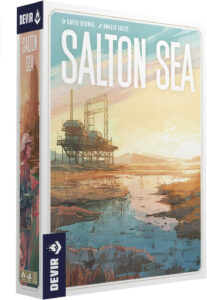 To look at the gorgeous and near-serene pastel cover is to enter a space of relaxation. You feel a gentle breeze as you peer into the bright blue sky with swatches of white clouds. The sun glimmers off—what is that—a power plant of some sort? And the ground is shaking. What is that horrible sound? Is that a drill breaking through the dried-out landscape?
To look at the gorgeous and near-serene pastel cover is to enter a space of relaxation. You feel a gentle breeze as you peer into the bright blue sky with swatches of white clouds. The sun glimmers off—what is that—a power plant of some sort? And the ground is shaking. What is that horrible sound? Is that a drill breaking through the dried-out landscape?
The light fades as the sun slinks away from the inevitable attempts at progress by Earth’s most infamous species. Enter Salton Sea, published by Devir and designed by David Bernal, a game about discovery, change, and as one would guess, profits.
Gameplay Overview:
Players take on the role of a company attempting to build industry to extract brine and turn it into both geothermal and lithium energy sources. To do this, they begin with four workers and a wide range of actions available to them. They also start with a hand of seven multi-use cards that can be used as either currency or improved actions. Actions are quick during play, but there is also plenty of analysis required to remain efficient.
A round consists of players using all available workers. Each turn presents a scope of available actions that either increase the production engine (industrial) or increase profits (commercial). Other actions available to players are called management actions and provide ways to invest internally. Action spaces are on each player’s individual board and each space can only be activated once per round.
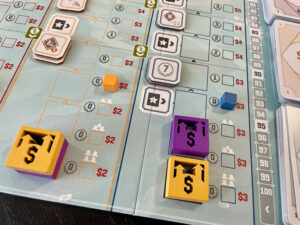
Salton Sea revolves around efficiently taking actions. Before we drill into some of those actions, it’s important to highlight the card system. All players begin with the same hand seven different improved-action cards. Each card is also worth one dollar. Money is used for a variety of purchases and each payment removes potential improved actions from your hand. Thankfully there are ways to add currency back into your hand (via a card market), and it is this interconnectivity that provides the game’s tension.
The Industrial Actions focus on developing an extraction and processing engine. Players must acquire drilling licenses, then drill, then extract brine from the earth. Brine can then be processed into energy sources at significant cost while also pushing their workforce to optimize results. Optimization and drilling both damage equipment. As such, there is also a repair action to get these back into pristine shape.
The Commercial Actions focus on selling extracted and processed resources to the available market. There are three corporations on a central board that offer specific pricing for each resource. These prices update over time as more players sell to them and supply/demand changes. There are also private contract actions available to sell resources for bonuses including currency and points.
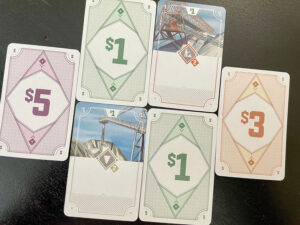
The Management Actions focus on improving your company. These come in the form of gaining research cards that provide ongoing or one-time abilities, buying shares into the central companies for one-time bonuses and potential end-game scoring, as well as developing your business plan to add more workers and inventory. Players can acquire up to seven workers through development and also add up to three additional warehouse locations.
The game ends when either the drilling license deck is empty or two central-board companies close. Those companies close when they’ve received enough assets from the market, and this is tracked via each sell action. Scoring includes, but is not limited to, public objectives, leftover currency, and resources, as well as negative points for damaged equipment.
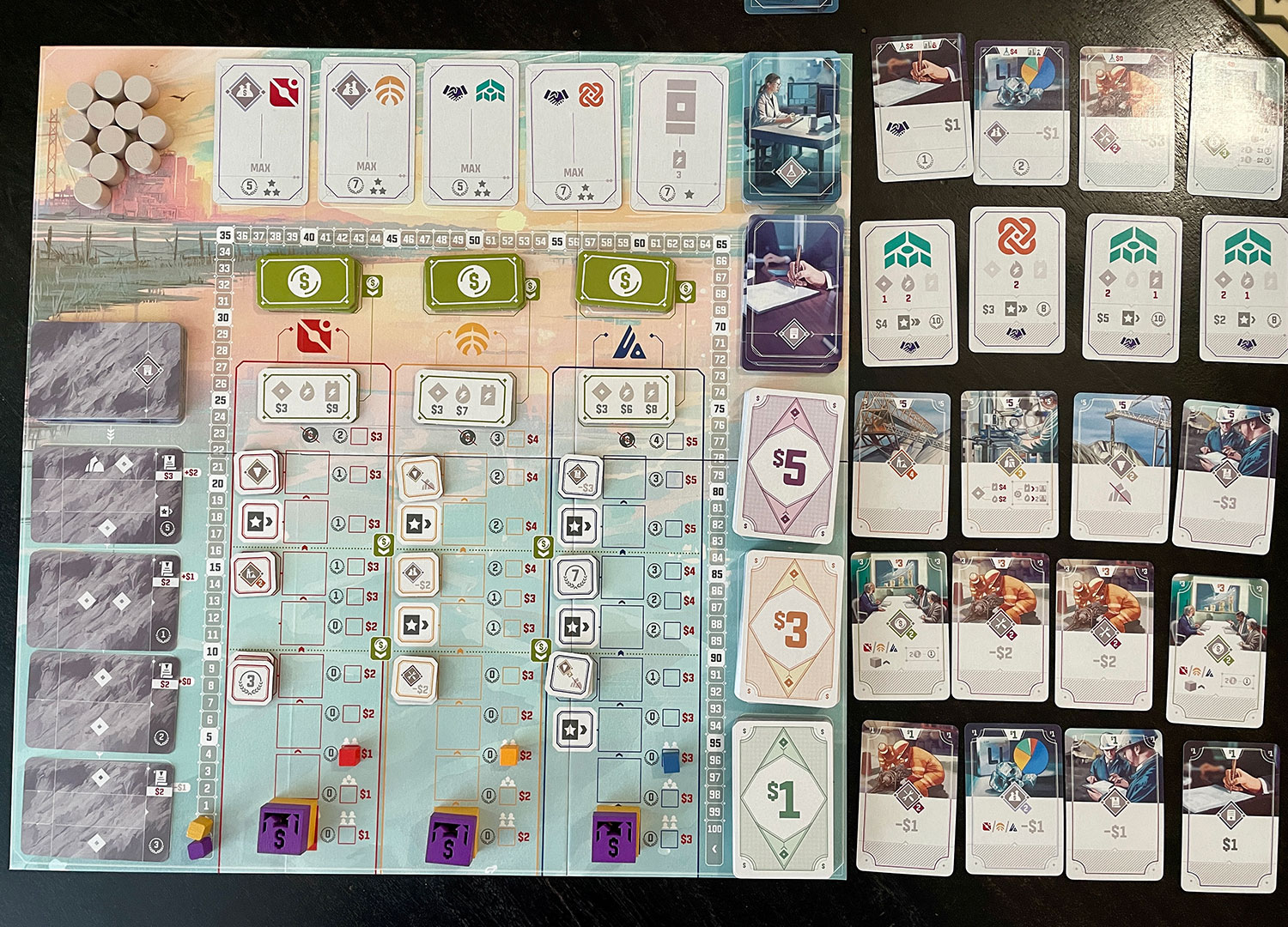
Game Experience:
Publisher Devir is known for providing a lot of game in a small package. This remains the case here and if there was a metric for amount of crunch per cubic inch of box size, this would be mighty crunchy indeed. Salton Sea has a very deceptive outward appearance. After setting up, the game takes up space. It has heft and presence. And it is quite punishing.
But punishing in a great way! For the most part.
Stepping into a first game with seasoned players may prove fatal. The efficiency engine at the game’s core can take a couple of plays to grasp. Early plays may find players struggling to adapt to the constant need to forgo improving their actions to use cards as currency. Running out of liquidity can set you back several turns.
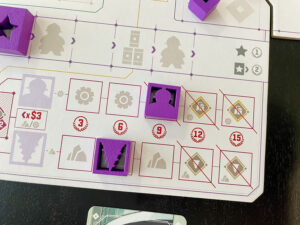
The tense decision space contrasts with a player turn. It’s simple. Place a worker. Take the action. Some turns find you drilling, which requires you to move your drill token down a step. That’s it. On to the next player. But surrounding that decision to drill is the whirlwind of potential efficiencies to make the action better. Do you play a card as an action to drill further? Do you seek a research card to boost the action? Many times, using the simple actions on the player board feels like giving up.
Salton Sea may appear disjointed at first glance. Much of the action takes place away from the central board and card market. The joy here is bringing items to your space to manipulate your process. As such, there’s a slight thematic boost of feeling like separate companies working to fulfill the energy needs of the larger corporations. The potential actions, the evolving economy, the damaged equipment, the revolving contracts. There is life built into the system.
That said, in these early plays of the game I’m not certain that it needs to be as punishing as it is. Salton Sea thrives on its card system and yet it tries to keep that at arm’s length with its process and sell actions. It costs quite a bit to process brine into new energy sources. I can see that being the case thematically, but it’s also a pinnacle moment that asks players to rebuild again. Bye-bye liquidity. And not getting improved sell cards early grinds a player economy to a halt.
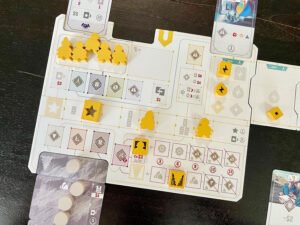
Thankfully players retain any cards they play as improved actions. And the thematic tie to capital being attached to these improved options is well considered. The card market to gain new actions (and money) comes in denominations of one, three, and five, and another puzzle to be considered is the fact that no change is given when paying with cards. The market is generous due to repeat card types but can be punishing as it doesn’t refresh until the end of the round.
The most egregious issue I have with Salton Sea is related to some of its design elements. The different buckets of actions could’ve been more cleanly delineated to increase their thematic presence. The printed lines connecting everything doesn’t really make sense. Also, the worker placement spaces being indicated by diagonal lines takes time to internalize as it isn’t not as clear as it could be. Plus, research cards may come with worker-placement spaces or ongoing abilities, but the design does little to differentiate the two.
One final sticking point is the central market. The evolving economy is great. And the share tracks can provide some fun one-time bonuses, but the investment into shares pulls away from the true joy of the game. It feels like one inclusion too many, especially when players would rather strive for contracts and public objectives and their benefits. I do wonder how the design would play with less focus on the markets and more on the environment.
Final Thoughts:
I think this design is flying under the radar due to many of Devir’s other more high-profile releases. Overall, I do think that Salton Sea comes together into a unique package that fits squarely into their small-box big-gameplay offerings. It tackles a unique setting, finds ways to integrate thematic elements to each action, and keeps the pace moving with a constant end-game timer waiting to shut things down. I enjoy the punishing decision space, but also wonder whether it’s too punishing, especially for new players. Whether this is a commentary on the struggle to produce new energy sources, or just designer David Bernal’s style of choice, it is going to rub some the wrong way. I recommend giving it a try though, especially at three players where it shines the best.
Final Score: 3.5 stars – A wonderfully punishing design that lacks a bit of seasoning.
 Hits:
Hits:
• Cards as currency
• Thematic integration
• Efficiency puzzle
Misses:
• Share tracks
• Design missteps
• Financing woes





















